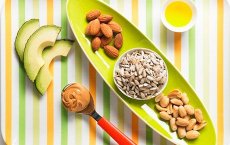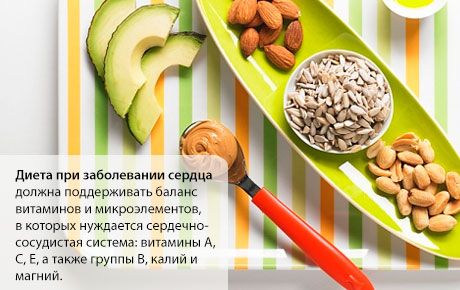Medical expert of the article
New publications
Diet for heart disease: a balanced diet for successful treatment
Last reviewed: 04.07.2025

All iLive content is medically reviewed or fact checked to ensure as much factual accuracy as possible.
We have strict sourcing guidelines and only link to reputable media sites, academic research institutions and, whenever possible, medically peer reviewed studies. Note that the numbers in parentheses ([1], [2], etc.) are clickable links to these studies.
If you feel that any of our content is inaccurate, out-of-date, or otherwise questionable, please select it and press Ctrl + Enter.

A diet for heart disease should maintain a balance of vitamins and microelements that the cardiovascular system needs: vitamins A, C, E, as well as group B, potassium and magnesium.
The optimal amount of food, its composition, caloric content and cooking methods, specially selected depending on a specific disease, are usually called a diet. Translated from Greek, diaita means "lifestyle", "regime".

Adherence to the principles of proper nutrition in cardiac pathologies is aimed at strengthening the heart muscle, normalizing its work and reducing tissue swelling. Key principles of diet for heart disease:
- do not overeat to avoid obesity, complications with the stomach and overload of the heart;
- food should be easily digestible: less fat – less cholesterol – less atherosclerotic deposits on the walls of the coronary vessels;
- eating small meals 5-6 times during the day;
- limiting salt intake (up to 3-5 g per day) – to combat swelling and cardiac overload;
- limiting fluid intake (up to 1-1.5 liters per day, depending on the diagnosis and the patient’s condition) – for the same purpose;
- limiting sugar consumption, which provokes the occurrence of edema.
Potassium is involved in muscle contraction, blood pressure regulation, and heart rate regulation. Foods with a high content of potassium salts include spinach, green onions, eggplants, potatoes (baked), Brussels sprouts, legumes (including peanuts), seaweed (kelp), pumpkin, bananas, apples, peaches, apricots (dried apricots), grapes (raisins), prunes, honey, and nuts.
Magnesium compounds help relieve vascular and muscle spasms, help synthesize proteins and remove cholesterol from the body. The list of foods with a high content of this microelement includes: wheat bran, pumpkin and sunflower seeds, sesame, almonds, pine nuts and walnuts, buckwheat, soy, olives, watermelon, dates, parsley, spinach.
Heart Disease Diet Menu
It is clear that this menu of the diet for heart disease (No. 10, 10A, 10C, 10I) is approximate. And here the main thing is to grasp the principle of rational nutrition and learn to vary dishes in accordance with the recommendations of nutritionists. Of course, those who cannot stand semolina porridge will cook oatmeal or buckwheat, and those who do not like stewed cabbage will cook vegetable stew.
So, what do doctors recommend to heart patients?
- For breakfast: steamed omelette or cottage cheese with sour cream (100 g), milk porridge (100 g), tea (200 ml).
- For second breakfast: orange or apple (fresh or baked).
- For lunch: vegetarian borscht or vegetable soup (200 g), lean boiled meat or poultry with a side dish of stewed vegetables (150 g), fruit dessert (100 g).
- For an afternoon snack: rosehip infusion, jelly or fruit juice (200 ml), 2-3 crackers or biscuits.
- For dinner: boiled sea fish (150 g) with stewed cabbage (100 g), tea or compote (200 ml).
- Before bed (2 hours before bed): 6 prunes or dried apricots, or a glass of kefir.
The recommended daily intake of bread is 200 g (half of which is rye), and sugar is no more than 35 grams.
According to calculations, the nutritional value of a diet for heart disease should be: 85 g of proteins (including 45 g of animal origin), 80 g of fats (including 30 g of vegetable origin), no more than 350 g of carbohydrates. At the same time, the total recommended caloric content is within 2200-2400 kcal per day.
Recipes for dishes for heart disease
Tips for cooking when you have heart disease:
- To reduce the fat content of meat broth, you need to boil the meat for 10 minutes, drain the water, pour fresh water over the meat and cook until done:
- To improve the taste of a dietary, undersalted dish, you can season it with dill, parsley, cilantro (coriander), tarragon, and basil.
Heart Disease Recipes: Salads
Potato salad
- 250 g of potatoes, boiled in their skins, peel and cut into cubes. Chop half an onion, a small fresh apple and parsley. Mix everything, season with olive oil.
Beetroot salad
- Peel and grate 300 g of boiled beetroot in its skin. Finely chop the onion (30 g), simmer it in a small amount of water, cool, sprinkle with lemon juice or vinegar, sprinkle with sugar (10 g) and let stand for 5 minutes. Then combine with the beetroot and season with a tablespoon of any vegetable oil.
Moroccan Parsley Salad
- Ingredients: 120 g parsley, 30 g onion, quarter lemon, 2 g salt. Finely chop the parsley and onion, mix with finely chopped lemon pulp, add salt and serve immediately.
Heart Disease Recipes: Soups
Diet soup with roots
For 2 liters of vegetable or weak meat broth you need to take: potatoes (3 pcs.), carrots (1 medium-sized pc.), parsley root (1 pc.), celery root (100 g), leeks (1 stalk), melted butter (half a tablespoon), salt (1 g).
Root vegetables - carrots, parsley and celery, as well as leeks, cut into small strips and simmer in melted butter, then add water and let boil for 5-10 minutes. Add diced potatoes and let boil for another 5 minutes. After that, put everything in a saucepan with boiling broth, add salt and cook until the vegetables are soft. Sprinkle with herbs when serving.
 [ 5 ]
[ 5 ]
Diet soup with spinach
For 1.5 liters of water or weak meat broth you will need: potatoes (300 g), carrots (1 medium-sized piece), spinach (250-300 g), medium onion, a bunch of dill, vegetable oil (tablespoon), salt (3 g).
Add diced potatoes to boiling water (or broth). Lightly fry grated carrots and chopped onions in vegetable oil and add after the potatoes. When the potatoes are almost cooked, add pre-chopped spinach and dill to the pan. After boiling, add salt to the soup and cook for another 3-4 minutes.
Recipes for dishes for heart disease: main courses
Macaroni casserole with meat and cheese
Required products: pasta (450 g), boiled beef or chicken (200 g), cheese (100 g), carrots (1 medium-sized), raw chicken eggs (2 pcs.), medium onion, vegetable oil, ground black pepper, salt (2-3 g).
Boil the pasta in salted water, drain the water. Lightly fry the grated carrots and chopped onions in vegetable oil. Finely chop the boiled meat (across the grain), grate the cheese.
Place half of the pasta in a greased form, then carrots with onions and meat. Put the rest of the pasta on top, pour over beaten eggs (like for an omelette) and sprinkle with grated cheese. Bake in the oven, preheated to +180-185°C, for 20-25 minutes.
Layered vegetable stew
To prepare this dish, which will be eaten with pleasure by those who do not follow a diet for heart disease, you need the following products:
Potatoes (2 pcs.), eggplant (1 medium-sized), one small zucchini (regular or zucchini), bell pepper (2 pcs.), garlic (2 cloves), a bunch of dill, sour cream (150-180 g), vegetable oil (4 tablespoons), salt (3 g).
Peel the potatoes, eggplant and zucchini and cut into thin slices. Remove the seeds from the pepper and cut into long thin slices. Pour vegetable oil into a cauldron or a saucepan with a thick bottom and lay out the vegetables in layers, adding salt and sprinkling with chopped herbs and garlic. Pour sour cream over everything and put in a hot oven for 45 minutes. It is not recommended to stir the stew during cooking.
Pumpkin and carrot pancakes
Grind 150 g of peeled raw pumpkin with a grater, do the same with 150 g of raw carrots. Make a semi-liquid dough from 100-150 ml of kefir or sour milk, one egg and 2-3 tablespoons of flour. Don't forget to add soda (on the tip of a knife) and a teaspoon of granulated sugar. Next, put the grated carrots and pumpkin into the dough and mix well.
The pancakes are baked in a heated frying pan greased with vegetable oil and served with sour cream.
According to the "father of medicine" Hippocrates, the effects of drugs are transient, while the effects of dietary means are long-lasting. So, be prepared for the fact that a diet for heart disease is an important part of your treatment. Moreover, the treatment is long-term, but very effective. And very tasty!
What can you eat if you have heart disease?
- lean meats (veal, rabbit, chicken, turkey);
- sea fish and seafood;
- eggs (no more than five per week);
- vegetable oil (olive, sunflower, corn);
- vegetables (fresh, stewed, steamed);
- rice, millet, buckwheat, oatmeal and barley groats, pasta;
- milk and dairy products (low-fat kefir, fermented baked milk, yogurt, sour cream, cottage cheese);
- legumes (beans, peas, lentils), corn, potatoes (boiled);
- whole grain bread;
- fresh fruit;
- nuts, dried fruits.
What should you not eat if you have heart disease?
- fatty meat and fish;
- butter, margarine, animal fat, lard;
- fresh bakery products made from premium flour; - everything fried;
- rich broths;
- canned goods, marinades, pickles (including sauerkraut);
- hot sauces and seasonings;
- strong tea, coffee and cocoa, alcoholic drinks;
- chocolate and chocolate candies.

